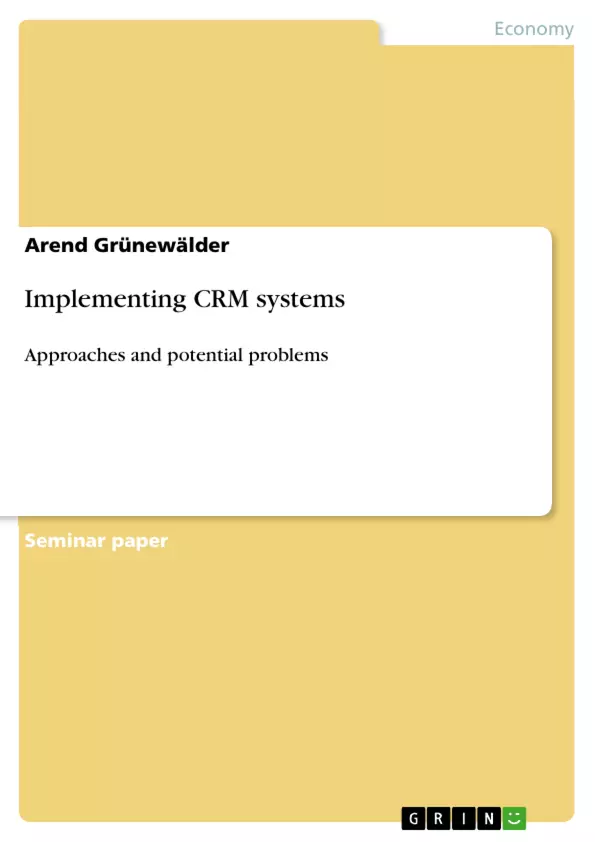Investing in information technology without relevant questions or a plan for application can lead to the development of a very expensive toy that offers no return on investment. While the planning and implementation of the CRM projects are examined in this work, potential organisational problems and barriers in the attitude of involved employees are analyzed for each implementation phase. The foundation of an accurate CRM implementation is the adoption of a firm’s strategy that should be designed to optimize both profitability and customer satisfaction. Many organisations today have discovered it is a mistake to think about Customer
Relationship Management (CRM) systems exclusively in technological terms. A
customer focus without accurate information is similar to attempting to circumnavigate
the planet without a map.1 Investing in information technology without relevant
questions or a plan for application can lead to the development of a very expensive toy
that offers no return on investment. While the planning and implementation of the CRM
projects are examined in this work, potential organisational problems and barriers in the
attitude of involved employees are analyzed for each implementation phase. The
foundation of an accurate CRM implementation is the adoption of a firm’s strategy that
should be designed to optimize both profitability and customer satisfaction.
To realize CRM, organisations must foster behaviours and implement processes and
technologies which support coordinated customer interactions throughout all customer
channels. In order to achieve this, organisations must develop the strategic and
functional components of the CRM projects. The implementation of a CRM strategy is
a series of small projects. These projects are all identified when the strategy is defined,
and they normally fall into the categories: developing a strategy, implementing
operational and analytical projects. If this is not done accurately and/or there is lack of
management understanding and commitment, the organisation can be exposed to
problems such as retention of employees or data quality problems. The organisation is
thus not in a position to initiate the desired customer relationship and to increase
revenues while at the same time reducing costs.
Inhaltsverzeichnis (Table of Contents)
- Executive Summary
- Table of Contents
- List of abbreviations
- List of figures
- Introduction
- Background
- Customer Relationship Management (CRM)
- Objectives and Benefits of CRM
- CRM Process
- An Inherent Problem of Strategy Implementation
- The Implementation Phases of CRM Systems
- Strategic CRM versus Functional CRM
- Developing a CRM Strategy
- Operational CRM Projects
- Analytical CRM Projects
- Deploying Operational and Analytical Outputs
- Conclusion
- Bibliography
Zielsetzung und Themenschwerpunkte (Objectives and Key Themes)
This work examines the importance of Customer Relationship Management (CRM) systems within organizations. It emphasizes that CRM should not be viewed solely as a technological solution but rather as a strategic approach to enhancing customer relationships and achieving business goals. The paper outlines the critical steps involved in implementing CRM systems, including developing a comprehensive strategy, managing operational and analytical projects, and addressing potential organizational challenges.- The strategic importance of CRM beyond technology.
- The role of information and strategy in CRM success.
- Implementation phases of CRM systems.
- Potential organizational challenges and barriers during implementation.
- The importance of employee attitudes and behaviors in CRM success.
Zusammenfassung der Kapitel (Chapter Summaries)
- Introduction: This section provides a brief overview of the topic, introducing the significance of CRM systems within the context of modern business practices. It highlights the need for a strategic approach to CRM implementation, emphasizing that technology alone is insufficient for success.
- Background: This chapter delves into the definition and core concepts of CRM, outlining its objectives and potential benefits. It also explores the essential components of the CRM process, highlighting its role in improving customer relationships and enhancing organizational performance.
- An Inherent Problem of Strategy Implementation: This section examines a common challenge faced in strategy implementation, specifically focusing on the potential disconnect between strategic intentions and their practical application within organizations.
- The Implementation Phases of CRM Systems: This chapter outlines the various phases involved in implementing CRM systems, emphasizing the importance of a well-defined strategy that guides the entire process. It explores different types of CRM projects, including strategic, operational, and analytical, detailing their roles in achieving CRM goals.
Schlüsselwörter (Keywords)
The main keywords and focus topics of this work include Customer Relationship Management (CRM), strategic implementation, operational CRM, analytical CRM, organizational challenges, employee attitudes, and business benefits. This work examines how organizations can leverage CRM systems to improve customer relationships, enhance profitability, and achieve sustainable growth.- Arbeit zitieren
- Arend Grünewälder (Autor:in), 2007, Implementing CRM systems, München, GRIN Verlag, https://www.grin.com/document/112261



